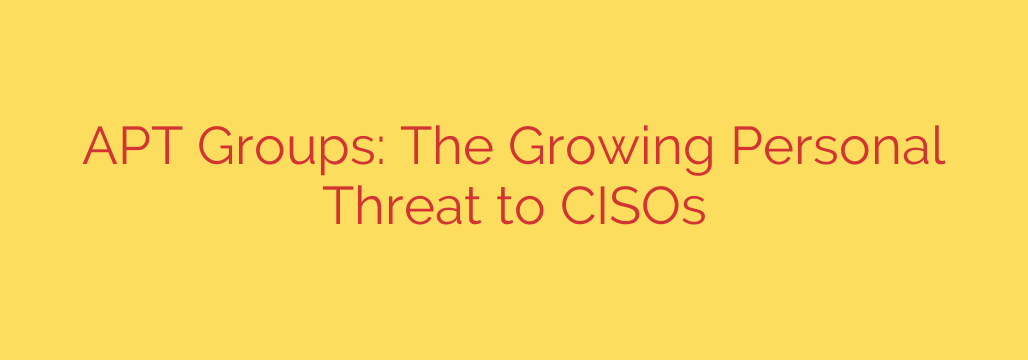
The CISO’s Dilemma: When Cyberattacks Get Personal
As a Chief Information Security Officer (CISO), you operate on the front lines of a digital war. You are the guardian of your organization’s most valuable assets, constantly defending against a barrage of sophisticated threats. But the nature of that war is changing. The battlefield is no longer confined to corporate networks and servers; it’s expanding to include your personal life.
Advanced Persistent Threat (APT) groups and other sophisticated attackers have realized that the most direct path into a fortified organization is often through its leader. You, the CISO, have become the high-value target. This isn’t about random phishing attempts; this is a calculated shift toward personal, targeted attacks designed to compromise, coerce, or impersonate you.
The Shift in Tactics: Why Attackers Are Targeting You
The logic behind this strategy is brutally simple. CISOs are the gatekeepers. Compromising a CISO offers attackers a level of access and intelligence that is nearly impossible to achieve through traditional means.
- Privileged Access: You hold the “keys to the kingdom,” with administrative credentials and deep knowledge of the security architecture, its weaknesses, and its blind spots.
- Unmatched Authority: Your position allows you to authorize high-risk changes, approve access requests, and direct security teams. An email or message seemingly from you carries immense weight.
- Psychological Pressure: Attackers know the immense stress you are under. By making the threat personal, they aim to create psychological distress, forcing a mistake or creating an opportunity for extortion.
CISOs are now prime targets because they represent the ultimate insider threat if compromised. Attackers are no longer just hacking companies; they are hacking people, and you are at the top of their list.
Common Attack Vectors Aimed at Security Leaders
Understanding the methods attackers use is the first step toward building a robust defense. These aren’t hypothetical scenarios; they are actively being deployed against security executives today.
Sophisticated Impersonation: This goes far beyond a simple fake email. Attackers create highly convincing, but fraudulent, social media profiles, especially on platforms like LinkedIn. They meticulously copy your career history, connections, and even your style of posting. The goal is to use this fake persona to trick your colleagues, business partners, or employees into revealing sensitive information or granting access.
Doxing and Intimidation: Doxing is the act of publishing private, identifying information about an individual online. For a CISO, this could mean having your home address, phone number, family members’ names, or children’s school information posted on public forums. The line between your professional and personal safety is deliberately blurred to intimidate you into compliance or silence. This tactic can be used to extort you for access credentials or to simply harass you into making a security error under duress.
Targeted Credential Harvesting: Attackers will relentlessly probe your personal digital life—your private email, social media accounts, and any other online services you use. They hunt for weak or reused passwords, hoping to find a credential that grants them a foothold. A compromise of your personal accounts can become a direct gateway to your corporate network, especially if you have ever reused a password or linked accounts.
Actionable Steps to Protect Yourself
The threat is personal, so your defense must be as well. While organizational security is paramount, you must now treat your personal digital hygiene with the same level of seriousness you apply to your corporate environment.
Conduct a Personal Digital Footprint Audit:
Take inventory of all your online accounts, both active and dormant. Scrutinize the privacy settings on every social media platform. Ask yourself: What information is publicly visible? Could this information be used to answer security questions or build a convincing profile for a social engineering attack?Enforce Strict Credential Management:
This is non-negotiable. Use a reputable password manager to generate and store unique, complex passwords for every single account. More importantly, multi-factor authentication (MFA) must be enabled on every service that offers it, from your primary email to your social media and financial accounts. This is your single most effective defense against credential theft.Separate Your Personal and Professional Identities:
Never use your work email address to sign up for personal services, and vice versa. This separation creates a crucial barrier that makes it harder for attackers to pivot from a personal breach to a corporate one. Assume anything you post publicly can and will be weaponized by a determined adversary. Be mindful of the details you share online, even in what seems like a private setting.Leverage Executive Protection Services:
Work with your organization to extend threat intelligence and protection services to cover you personally. This can include monitoring the dark web for your credentials, scanning for impersonating social media profiles, and even utilizing data removal services to scrub your personal information from data broker websites.
The role of the CISO has evolved. You are no longer just defending a perimeter; you are the perimeter. By recognizing the personal nature of modern cyber threats and taking proactive steps to secure your own digital life, you not only protect yourself and your family but also add a critical layer of defense to the organization you are sworn to protect.
Source: https://www.helpnetsecurity.com/2025/08/12/apt-executive-cybersecurity-threats/








